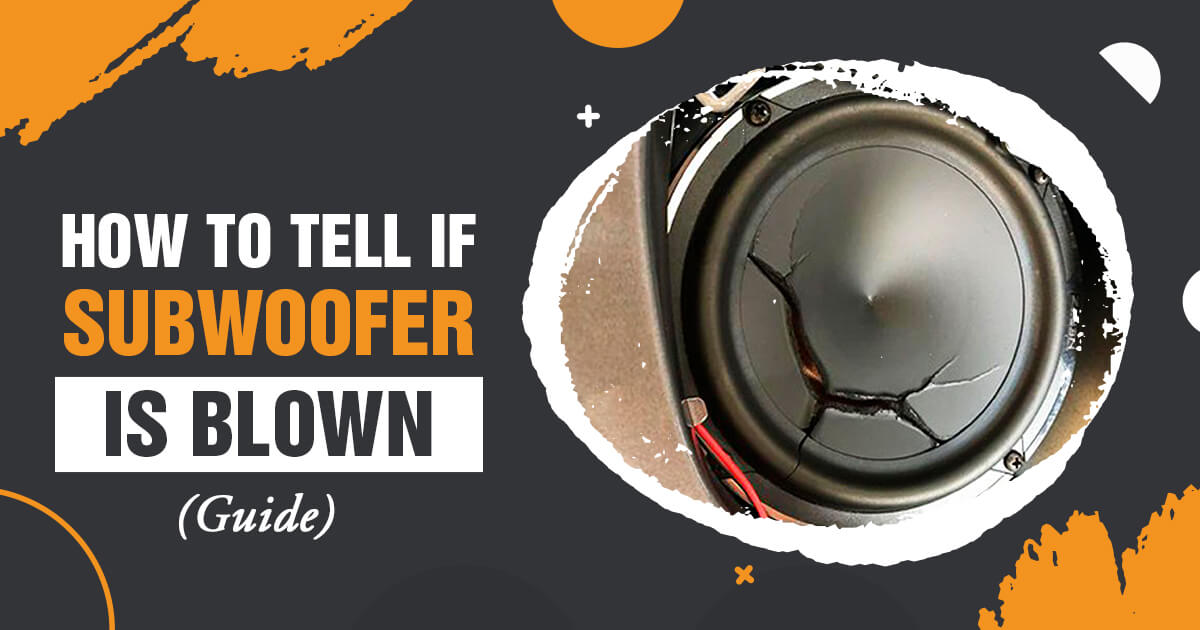If you notice any of these symptoms, don’t worry. There are many ways to tell if your subwoofer is blown and what to do about it once you know that there are problems.
In this article, we will tell you how to test if a subwoofer is blown and the causes of a blown subwoofer.
Keep reading if you want to learn more about:
How To Test If A Subwoofer Is Blown
Testing blown coil
Testing if your subwoofer has a blown coil will give you the most accurate result, but it is also the most challenging way to test for this problem.
- Cautiously take apart your subwoofer without disconnecting any wires or taking out speaker terminals.
- Then find the voice coil attached to the cone of the speaker, which is usually very hot.
- Grab the bonded wire of the coil and gently tug at it as if you were trying to pull it off. If there is no movement, then the wire is stuck. If there is a lot of movement, it means that your subwoofer has a blown coil.
Testing the cone
Testing the cone of your subwoofer is a much easier way to test for blown speaker drivers.
Start by powering on the amplifier and playing some bass-heavy music at normal listening levels. With your other hand, grab onto the cone of your subwoofer by placing it near any open frame or hole in the front of your enclosure, then give a gentle tug towards yourself.
If your subwoofer’s cones move, but there is no sound coming from them, then you have a blown driver.
Testing the sound
If your subwoofer is making a strange noise and you can’t exactly tell what it is doing, then testing the sound. It is the easiest way to find out if there are blown subwoofers or not.
Turn on your amplifier and play some music at normal listening levels. Then put your ear up to the cone of your subwoofer and listen carefully for any noise. If you hear an abnormal noise, such as hissing or scratching noises, then your subwoofer has blown speakers.
Voltage Check
The bass from a subwoofer is typically measured in watts. However, when it comes to trying to figure out if your subwoofer has been blown, you’ll want to check the voltage.
To do this, set up a voltmeter and connect the meter’s positive lead with a wire running from the amplifier’s speaker terminal.
Then touch each end of an alligator clip on either side of where your speaker terminals are connected. This will allow you to measure how much voltage is going through your amp without actually touching any connections.
If there is no reading on the voltmeter or only one reading (barely anything), it’s likely that your subwoofer has been blown or needs some work done on it.
Physical Damage
The best time to test for physical damage is when your subwoofer stops producing sound or acts strangely after an accident occurs.
This could be anything from accidentally dropping your enclosure or getting into an accident with another car or person.
In this case, disconnect your subwoofer from the amplifier and carefully detach any parts that may have been damaged. The cone of a subwoofer is very sensitive at times.
If it has been bent or shifted in some way, then you probably need to get a new one.
What Does A Blown Subwoofer Sound Like
The blown subwoofer sound is quite distinctive and awful. You can tell it’s blown because the woofer cone will be moving in and out without any bass coming from the speaker. When this happens, it usually makes a “whump”, “hissing”, but not all blown subs make that noise.
Blown speakers can sound like many different things, but the most common symptoms of blown drivers include:
- No bass or bass that is barely noticeable and sounds thin and weak.
- Distorted bass at high volumes
- A rattling noise coming from inside your enclosure
What Causes A Blown Subwoofer
Too much power
The most common reason subwoofers blow out is that they receive power above their recommended range. If you use a speaker with too much energy that your subwoofer can handle, the voice coils will overheat and fry, rendering them useless.
Excessive force will make the speakers draw more electricity than they should and will make them blow up.
Wire failures
Another electrical problem that can cause blown subwoofers is loose wiring connections. Although this is rare, it does happen when wires are not connected securely or if insulation fails to cover wire joints.
Condensation in poor connectivity causes high resistance, which could lead to overheating.
Mechanical Failures
The mechanical problem can affect the parts of the speaker that protect or support it. This will eventually cause a blown subwoofer.
The best way to avoid these mechanical accidents is through proper care and maintenance of your equipment.
Regularly inspect your speakers for signs of damage or wear and replace them before they have a chance to wreck your equipment.
Rusted and broken parts
If there is rust on any metal parts, then chances can break easily under heavy stress. A rusted terminal or seam will prevent the voice coil from making contact with the pole piece. This creates resistance and overheating, which leads to a shorted component and a blown speaker.
Can You Fix A Blown Subwoofer

The answer is yes and no. If you can take out the old speaker and put in a new one, it will work like new.
However, if the voice coil or wiring has been shorted or damaged, you probably won’t fix this problem. If your speaker has broken and there is no damage to its components, then you can take the old speaker out and put a new one in.
You have to consider whether you want to fix the old subwoofer or get a new one. It might cost more to fix the old one. You might be able to buy a new speaker instead for less money, and it will work better.
Conclusion
If you’re experiencing a sound issue with your subwoofer, then it’s time to deal with the problem.
Whether this is an occasional or frequent occurrence will determine how quickly you need to act. If you are looking for a quick fix, several things can be done to repair the speaker.
However, if this is something that happens frequently, then it might be time for an upgrade here.

